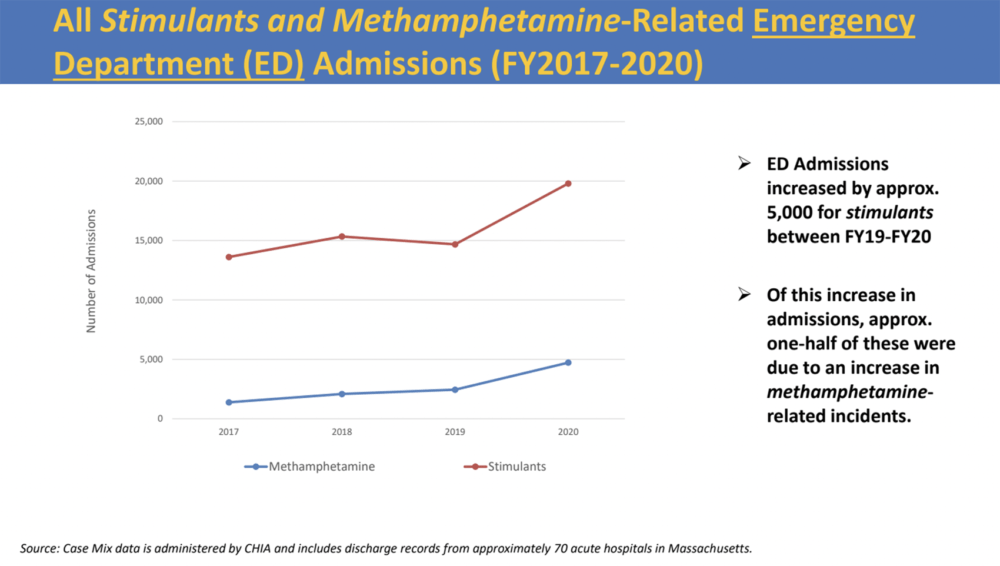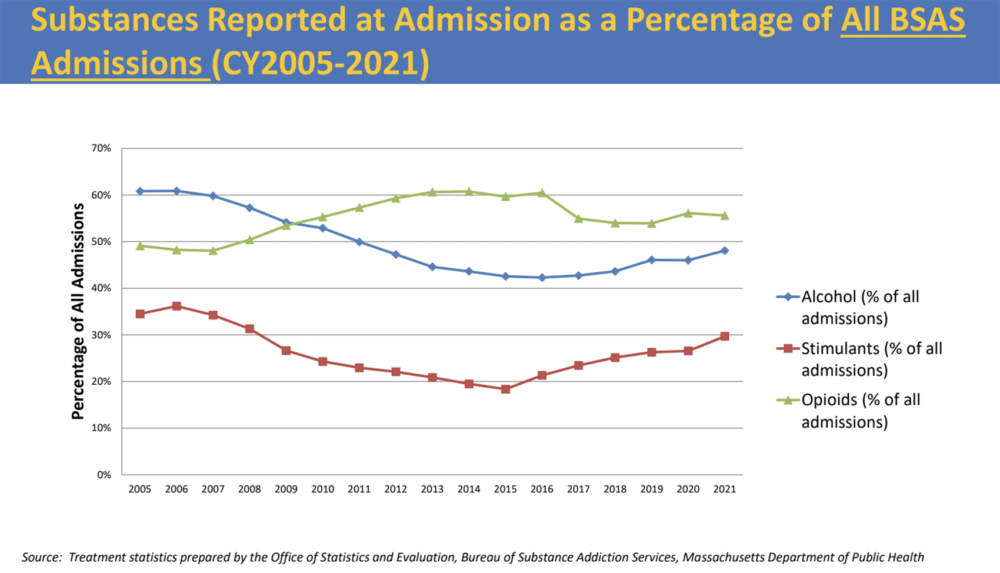Advertisement
As cocaine and meth use rise in Mass., state commission outlines action plan
Use of cocaine and methamphetamines is rising in Massachusetts. Emergency room visits are up for patients who are overamping, the stimulant version of an overdose. And 52% of overdose deaths in the first six months of 2021 involved cocaine. Most fatal overdoses also show fentanyl, a finding that’s one of many complications a state commission on meth and stimulant use has worked since late last year to untangle.
The commission’s final report, released earlier this month, makes clear that Massachusetts is not well-equipped to manage or treat stimulant use.

The commonwealth is not unique. For people addicted to opioids, there's a clear path to treatment. The path is anything but clear for people with a stimulant use disorder. There are no approved medications, many addiction treatment programs won’t accept patients high on stimulants, and first responders may not have training in the needed deescalation techniques.
The report’s recommendations address each of those issues. It starts with a broad mandate about adopting "a culture of harm reduction" in the Commonwealth.
The opioid crisis has long established the value of harm reduction in Massachusetts. Street outreach workers today carry clean needles, the overdose-reversing med naloxone (Narcan), fentanyl test strips and other tools to help drug users avoid dangerous infections and death. Now, the state’s stimulant commission says, Massachusetts must apply that safety-first approach to helping stimulant users.
"The United States just really hasn't accepted harm reduction as a part of our culture," said commission chair and the state's Health Secretary, Marylou Sudders at a meeting in March. "We have pockets but we really need to engage in a different way of thinking."
The report urges hospitals and community health centers to stock and distribute harm reduction supplies. For patients using cocaine or meth, that would include single-use pipes and pipe holders so that people don’t spread infections by sharing equipment. But, some of these supplies may be illegal under the state’s drug paraphernalia law. The report says harm reduction supplies and equipment to test drugs will soon be available at a state-run site.

As with opioids, the commission would also want to see harm reduction efforts include education about the importance of carrying naloxone and avoiding using stimulants alone since the drugs could contain fentanyl.
Commission meetings also included information about deadly counterfeit pills for sale on the street. The report recommends more state education campaigns to warn both casual and regular drug users and urge the testing of pills with fentanyl strips.
State data shows an increase in stimulant use among people seeking treatment. Many cocaine and meth users say they get drunk before arriving at a treatment facility so they can claim to be seeking help for an addiction to alcohol. They say they get turned away if they tell the program that their primary substance is a stimulant.

Providers testing new detox methods for stimulant drug users and longer term treatment spoke to the commission about their work and early findings.
Commissioners say contingency management should be offered widely in Massachusetts. In that approach, people addicted to stimulants are offered gift cards or other small rewards for keeping appointments, drug-free urine tests and meeting other treatment goals. The federal government caps payments to individuals at $75 a year but recently agreed to allow higher rewards using other funds.
The report lists many more tools and changes needed in Massachusetts to address rising cases of stimulant addiction, overdose and death. It calls for “cool down” centers — an alternative to emergency rooms — where drug users who are overamping could be safe while they come down off a high.
Commissioners ask that insurers pay for recovery coaches and other harm reduction specialists who’ve become valuable additions in some hospital emergency rooms. And they recommend more regular use of community drug testing programs. These programs could help feed a new state-run dashboard providing more real-time information about the drug supply and overdoses.
The commission’s recommendations are based on input from addiction treatment providers, police and EMS leaders, researchers as well as current and former stimulant users.
Stephen Murray, who spoke to the commission about his past struggles with meth, says he’s pleased with the report.
"It addresses many of the concerns I voiced during my testimony around the need to expand drug checking and fentanyl overdose by people who believe they are only using stimulants,” said Murray, now an overdose researcher at Boston Medical Center, in an online exchange.
Murray says state lawmakers can save many lives by adopting the commission’s recommendations and legalization of supervised consumption sites. In 2019, another commission proposed one or more pilots of these clinics where drug use is monitored to prevent overdose deaths, but lawmakers have not sent the proposal to the governor.
“I, like many others, are sick of losing our friends,” Murray said. “I really can’t go a week without hearing about the death of somebody else I knew. The time is now. Enough’s enough.”
The rise in stimulant use varies across the state, according to the commission report, so efforts to reach people most at risk will need some tailoring. Meth is much more common in the Boston area than elsewhere and among white drug users. Men who have sex with men are 10 times more likely to use meth recreationally than the general population, the report says. Crack and cocaine use is higher among Black and Latino drug users than whites.
And there are some workforce differences. The report says 28% of deaths linked to cocaine were among people working in construction or a trade, according to the most recent statewide numbers, and 19% were among people who were unemployed, students or homemakers.
This article was originally published on May 11, 2022.
